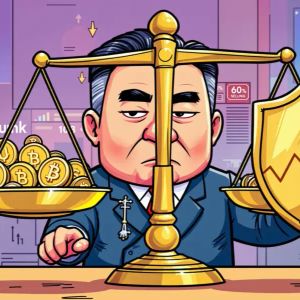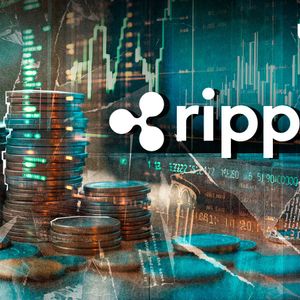South Korea Crypto Lending: Crucial Steps to Safeguard Investors
8 min read
BitcoinWorld South Korea Crypto Lending: Crucial Steps to Safeguard Investors The world of cryptocurrency is a whirlwind of innovation and opportunity, but with great potential comes great responsibility, especially for financial authorities. If you’re invested in the digital asset space, particularly within the dynamic Asian market, then the latest developments from South Korea are something you absolutely need to pay attention to. South Korea, a major player in the global crypto arena, is now setting its sights on regulating South Korea crypto lending services, a move that could significantly reshape how digital assets are traded and secured. This isn’t just about minor adjustments; it’s about building a robust framework to protect investors from the inherent risks of high-leverage products and speculative practices like short selling, which have long been common in traditional finance but largely unregulated in crypto. Understanding the Landscape: Why South Korea Crypto Lending Needs Regulation For years, the burgeoning cryptocurrency market has operated with a relatively light touch from regulators, especially when it comes to sophisticated financial products like crypto lending. While this freedom has fostered rapid innovation, it has also created significant vulnerabilities. In South Korea, authorities have grown increasingly concerned about the proliferation of high-leverage products offered by prominent local exchanges such as Upbit and Bithumb. These platforms, while popular, have been operating without a clear legal framework governing lending activities, leaving investors exposed to substantial risks. Think of it this way: in traditional stock markets, short selling – betting on a price decline – is heavily regulated. There are rules about borrowing shares, collateral requirements, and transparency. In the crypto world, similar lending and borrowing mechanisms, often used for short selling or highly leveraged trading, have lacked such oversight. This absence of regulation means: Increased Volatility Risk: High leverage can amplify both gains and losses, leading to rapid liquidations and market instability. Lack of Investor Protection: Without clear rules, investors have limited recourse in cases of platform insolvency, technical glitches, or predatory lending practices. Systemic Risk: Uncontrolled leverage across multiple platforms could pose a systemic risk to the broader financial ecosystem if a major market downturn occurs. The urgency for regulation stems from a desire to mature the market, bringing it closer to the standards of traditional finance while still allowing for innovation. The goal is not to stifle growth but to ensure it happens responsibly, with a strong emphasis on investor safeguarding. This proactive stance on South Korea crypto lending is a clear signal that the nation is serious about creating a safer environment for its digital asset participants. The Regulatory Push: What’s Driving South Korea Crypto Lending Rules? The push for tighter regulations on South Korea crypto lending is a direct response to a growing recognition of the risks involved. Financial authorities are acutely aware that while crypto offers immense potential, the current lack of a legal framework for services like lending and short selling leaves a gaping hole in consumer protection. The current situation is akin to a Wild West scenario, where platforms operate largely based on their own internal policies rather than standardized, legally binding rules. The main drivers behind this regulatory urgency include: Protecting Retail Investors: Many individual investors, drawn by the allure of high returns, may not fully comprehend the complex risks associated with leveraged trading and crypto lending. Regulators aim to shield them from potential financial ruin. Ensuring Market Stability: Uncontrolled leverage and speculative activities can exacerbate market downturns, creating a domino effect that could impact the wider financial system. Regulation seeks to mitigate this systemic risk. Combating Illicit Activities: A lack of clear rules can inadvertently create loopholes for money laundering and other financial crimes. Establishing a robust framework helps in monitoring and preventing such activities. Aligning with Global Standards: As other major economies move towards comprehensive crypto regulation, South Korea is keen to keep pace, ensuring its financial markets remain credible and competitive on the global stage. Despite the clear need, the path to full legislation is not straightforward. Experts anticipate that developing and implementing a comprehensive legal framework could take anywhere from one to two years. This timeline highlights the complexity of crafting rules for a rapidly evolving technological and financial landscape. In the interim, authorities are exploring various measures to bridge this gap, ensuring that some level of oversight is in place while the full legislative process unfolds. This dual approach underscores the government’s commitment to immediate action while building for the long term in South Korea crypto lending . How Will New South Korea Crypto Lending Guidelines Impact You? The anticipated regulations on South Korea crypto lending are set to introduce significant changes, impacting both crypto exchanges and individual investors. While full legislation is a few years away, interim guidelines and the potential for self-regulation are already on the table. This means changes could start to trickle down sooner than you think. Here’s a breakdown of what these new guidelines might entail and their potential impact: Aspect Current Landscape (Pre-Regulation) Anticipated Changes (Post-Regulation) Leverage Limits Often high, with platforms offering significant multipliers on trades. Exchanges urged to limit leverage, reducing exposure to extreme volatility. Investor Protections Limited legal recourse; terms set by individual platforms. Enhanced investor safeguards, potentially including clearer risk disclosures, cooling-off periods, and compensation mechanisms. Transparency Varies by platform; often opaque regarding lending pool sources and risks. Increased transparency requirements for lending services, including collateralization and liquidation processes. Platform Accountability Primarily self-governed, with limited external oversight on lending. Greater regulatory scrutiny; potential for fines or sanctions for non-compliance; possibility of self-regulation frameworks overseen by industry bodies. Product Offerings Wide array of high-risk products available without strict checks. Potential restrictions or stricter vetting for high-risk lending products, especially those akin to short selling. For investors, this means a potentially safer, albeit possibly less speculative, environment. While the thrill of extreme leverage might diminish, the trade-off is a more secure investment landscape where your assets are better protected. Exchanges like Upbit and Bithumb will need to adapt their business models, focusing more on compliance and investor education. This shift is crucial for fostering long-term trust and attracting a broader, more conservative investor base into the digital asset market. Navigating the Future: The Path Ahead for South Korea Crypto Lending The journey towards comprehensive regulation for South Korea crypto lending is an evolving process, characterized by a blend of urgency and careful deliberation. The immediate focus is on implementing interim guidelines that can provide a stop-gap solution to current risks, while the longer-term objective involves crafting a robust legislative framework. This phased approach allows regulators to respond to immediate concerns while developing well-thought-out policies that can stand the test of time. Key aspects of this future path include: Interim Guidelines: These are expected to be issued relatively soon, providing immediate direction to exchanges on practices like leverage limits and risk disclosures. These aren’t full laws but strong recommendations that exchanges will be pressured to adopt. Self-Regulation Initiatives: The industry itself may play a significant role. Exchanges could be encouraged, or even mandated, to develop self-regulatory frameworks. This would involve establishing industry best practices, codes of conduct, and internal compliance mechanisms, often under the watchful eye of a government-appointed body. Legislative Development: The 1-2 year timeline for full legislation indicates a thorough process involving multiple stakeholders, including financial experts, legal professionals, and industry representatives. The aim is to create laws that are effective, enforceable, and adaptable to future innovations in the crypto space. Global Collaboration: South Korea’s regulators will likely observe and learn from regulatory approaches in other leading crypto jurisdictions. This international perspective can help them design rules that are both locally relevant and globally aligned, fostering a more harmonious international crypto market. For those involved in the South Korean crypto market, staying informed and adapting to these changes will be paramount. Investors should prioritize platforms that demonstrate a commitment to compliance and investor safety, even before full regulations are in place. For exchanges, proactive engagement with regulators and early adoption of best practices will be key to navigating this transformative period successfully. This regulatory evolution is not just about control; it’s about legitimizing the crypto space, making it safer, more transparent, and ultimately, more sustainable for everyone involved. A Secure Horizon: The Promise of Regulated Crypto Lending The steps being taken by South Korea to regulate South Korea crypto lending services mark a pivotal moment for the nation’s digital asset market. While the road to full legislation may be long, the commitment to enhancing investor protection and mitigating risks associated with high-leverage products is clear and unwavering. This proactive approach, driven by concerns over practices akin to short selling in traditional markets, signals a maturing industry where accountability and transparency are becoming paramount. As interim guidelines are rolled out and a comprehensive legal framework takes shape, investors can look forward to a more secure and predictable environment. This regulatory evolution is not merely about compliance; it’s about building trust, fostering sustainable growth, and solidifying South Korea’s position as a responsible leader in the global cryptocurrency landscape. The future of crypto in South Korea appears to be one where innovation is balanced with robust safeguards, ensuring a safer journey for all participants. To learn more about the latest crypto market trends, explore our article on key developments shaping Bitcoin price action. Frequently Asked Questions (FAQs) Here are some common questions about South Korea’s new crypto lending regulations: Q1: What exactly are South Korea’s financial authorities planning to regulate? A1: South Korea’s financial authorities are planning to regulate crypto lending services, particularly those involving high-leverage products and practices similar to short selling found in traditional financial markets. This includes services offered by major exchanges like Upbit and Bithumb. Q2: Why is South Korea focusing on crypto lending regulation now? A2: The primary reasons are concerns over high-leverage products that expose investors to significant risks, the current lack of a legal framework for these services, and the need to enhance investor protection and market stability. They aim to prevent potential financial harm to retail investors. Q3: How long will it take for full legislation to be implemented? A3: Full legislation is expected to take approximately one to two years to be developed and implemented. In the interim, regulators are urging exchanges to adopt interim guidelines and explore self-regulation to address immediate concerns. Q4: How will these new rules impact crypto exchanges in South Korea? A4: Exchanges like Upbit and Bithumb will likely be required to limit the leverage offered on their platforms and enhance their investor protection measures. They will need to increase transparency and comply with new interim guidelines, potentially leading to adjustments in their product offerings and operational models. Q5: What does “short selling risks” mean in the context of crypto? A5: In crypto, “short selling” often involves borrowing digital assets to sell them, hoping to buy them back at a lower price later to profit from the difference. This practice, especially when combined with high leverage, can lead to amplified losses if the market moves against the trader, posing significant risks that regulators aim to mitigate. Found this article insightful? Share it with your network! Help spread awareness about the crucial regulatory changes happening in the South Korean crypto market and empower others with knowledge about investor protection. Your share makes a difference! This post South Korea Crypto Lending: Crucial Steps to Safeguard Investors first appeared on BitcoinWorld and is written by Editorial Team

Source: Bitcoin World



